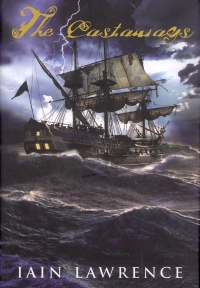| ________________
CM . . .
. Volume XIV Number 9 . . . .December 21, 2007 
 |
The Castaways.
Iain Lawrence.
New York, NY: Delacorte Press (Distributed in Canada by Random House of Canada), 2007.
243 pp., hardcover, $20.99.
ISBN 978-0-385-73090-7.
Subject Headings:
Adventures and adventurers-Fiction.
Seafaring life-Fiction.
Slave trade-Fiction.
Caribbean Islands-History-19th century-Fiction.
Grades 5-9 / Ages 10-14.
Review by Pam Klassen-Dueck.
**** /4
|
| |
|

excerpt:
The axe was passed from Penny to Weedle to me. I led Midgeley to the bow. He laid himself down, on his side, with not so much as a whimper. I rubbed his arm, then ran my fingers through his hair as he spoke to me softly.
"It was supposed to be Penny," he said. "But I was too eager, weren't I? It's justice, Tom."
"Justice? Why, there's no justice here." I felt as though my heart had been torn away. "It's the curse, Midge. It's that dreadful diamond."
"No, it ain't that, Tom. Luck was never with me, that's all." He put his hand in mine. "I was never meant to inherit no earth."
Benjamin Penny came creeping forward. "You're wasting time," he said. "Bash his head or I'll do it myself."
The Dickensian nautical adventure that began with The Convicts and The Cannibals continues in riveting form with The Castaways. Tom Tin leaves his father on a cannibal island and attempts to sail back to England, along with a few friends and dubious acquaintances, in order to reclaim his precious Jolly Stone. Although his straightforward plan is to sell the diamond (including its accompanying curse) to his arch enemy, Mr. Goodfellow, nothing involving Tom Tin is ever that simple!
Tom Tin, who is reminiscent of Pip in Great Expectations, longs to be a gentleman. Destitute and nearly orphaned, he plans to sell the Jolly Stone in order to have enough money to rise to the top of the social classes in London, as well as to rid himself of the jewel's curse. The Jolly Stone functions as a prompt toward evil, as it propels Tom to desire wealth above his friends. Throughout the narrative, he continues to battle his character flaws, particularly that of selfishness, and his friends act as constant reminders to him of what he truly values.
In keeping with the first two novels of the trilogy, The Castaways is characterized by colourful descriptions of grotesque scenes. For instance, as the starved boys approach an island, the ship begins to run out of fuel. In desperation, the boys chop at the boat, itself, in order to throw its materials into the firebox: "He chopped away at the seats, the knees that held them, the varnished decks at stem and stern. It seemed a dreadful thing to do to a boat, to feed it to its own fire." The vivid image of the self-cannibalizing boat serves to create a sense of urgency for the characters who are desperate for food and water. Other monstrous scenes run the gamut from Tom's near-enslavement to other characters' acts of suicide.
The most serious issue handled by the novel is that of slavery in the British colonies. Contained in the belly of the boys' ghost ship are abandoned slaves who died as they were chained in the hold. The children are unaware of the real voices making the ghostly sounds; the scene describing the trapped people's communication efforts is eerie and tragic: "There was a knocking like footfalls, and then a long groan of sadness. A rustling murmur, as though of breathing, came from the very hull." Tom is devastated by the discovery of the dead bodies in the hold. However, he is trapped in the colonial life. For instance, though Tom disagrees with the slave issue, he allows another person's slaves to clean the ship's hold of the dead bodies before he grants them their freedom. He is ashamed of this act, but he doesn't stop himself: 'In a selfish act I left them to it, only turning them free when the job was done." The tension between supporting the notion of empire and undermining it is very much in evidence throughout The Castaways. Simultaneously, Tom loves what Britain represents and is repelled by it. Throughout the novel, in fact, Tom battles enslavement in various forms, right to the last page, including his own overwhelming desire for riches and social power.
The book's wild plot twists may, at times, seem implausible. For instance, as Tom lies paralyzed in an unmarked grave, the bodysnatcher Worms, who is a featured character of the trilogy, makes a coincidental appearance to save him. Scene after scene in this story features bizarre coincidences. However, near-impossible plot twists are part of the great fun of Lawrence's novels; as well, happenstances are characteristic of many Victorian novels on which The Castaways is based.
With its combination of action and mystery, The Castaways maintains the energy of Lawrence's trilogy. The book's stunning cover art, dastardly villains, and fast-paced plot will attract and absorb Middle Years readers, particularly in light of the successful Pirates of the Caribbean movie franchise. In order to understand the complete back story of the trilogy, I recommend that the first two books be read before delving into The Castaways, although it is certainly not necessary in order to enjoy this story of murder and mayhem on the high seas. An open ending promises a fourth installment of this popular series.
Highly Recommended.
Pam Klassen-Dueck, a Middle Years teacher, is presently a graduate student in the M.Ed. program at Brock University.

To comment
on this title or this review, send mail to cm@umanitoba.ca.
Copyright © the Manitoba Library Association. Reproduction for personal
use is permitted only if this copyright notice is maintained. Any
other reproduction is prohibited without permission.
NEXT REVIEW |
TABLE OF CONTENTS FOR THIS ISSUE
- December 21, 2007.
AUTHORS |
TITLES |
MEDIA REVIEWS |
PROFILES |
BACK ISSUES |
SEARCH |
CMARCHIVE |
HOME |
